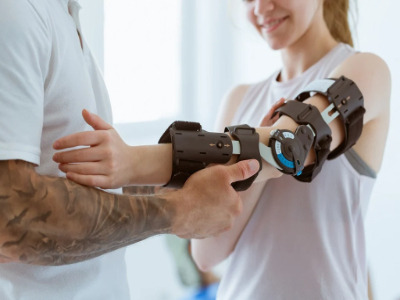#carbon fiber market trends
Explore tagged Tumblr posts
Text
Revolutionizing Industries: The Carbon Fiber Market Unveils Unprecedented Growth and Key Segments Forecast 2023-2032
The global carbon fiber market is experiencing a paradigm shift, marking an era of innovation, sustainability, and exceptional market growth. As industries increasingly embrace lightweight, high-strength materials, carbon fiber has emerged as the frontrunner, redefining the landscape of various sectors.
Report Sample:
Trends Reshaping the Carbon Fiber Market:
Sustainable Manufacturing: The carbon fiber market is witnessing a surge in demand for sustainably produced materials. Manufacturers are actively adopting eco-friendly processes, ensuring that carbon fiber production aligns with global environmental goals. This trend not only meets the growing demand for green products but also positions carbon fiber as a responsible and future-ready choice.
Advancements in Composite Technologies: Carbon fiber's integration with advanced composite technologies is propelling its adoption across industries. Innovations in resin systems, matrix materials, and manufacturing techniques are enhancing the overall performance of carbon fiber composites, making them versatile and suitable for diverse applications.
Aerospace Industry Dominance: The aerospace sector continues to be a key driver of carbon fiber market growth. The material's unmatched strength-to-weight ratio is revolutionizing aircraft design, leading to fuel efficiency, reduced emissions, and increased payload capacities. The aerospace industry's increasing reliance on carbon fiber reinforces its position as a cornerstone in the market.
Key Segments Redefining Possibilities:
Automotive Applications: Carbon fiber is rapidly gaining ground in the automotive industry, particularly in high-performance vehicles. The market is witnessing a surge in the use of carbon fiber-reinforced plastics (CFRP) for components such as body panels, chassis, and interiors. As automakers strive for lightweighting and improved fuel efficiency, carbon fiber becomes a game-changer.
Renewable Energy Infrastructure: The renewable energy sector is embracing carbon fiber for wind turbine blades and other critical components. The material's durability, corrosion resistance, and lightweight properties make it an ideal choice for enhancing the efficiency and lifespan of renewable energy infrastructure.
Medical Advancements: In the medical field, carbon fiber is finding applications in prosthetics, orthopedic devices, and medical imaging equipment. The material's biocompatibility and strength make it an attractive option for creating innovative solutions that enhance patient care and mobility.
Market Growth Projections:
The global carbon fiber market is poised for robust growth, with a CAGR expected to surpass previous estimates. The increasing demand for lightweight materials, coupled with advancements in manufacturing technologies, positions carbon fiber as a key player in shaping the future of numerous industries.
Industry leaders, stakeholders, and investors are urged to stay attuned to the dynamic developments within the carbon fiber market, as it continues to evolve and drive transformative changes across sectors.
Discount:
Keyplayers.
The global carbon fiber market profiles leading players that include DowAksa Advanced Composites Holding B.V, Formosa Europe, Solvay, TORAY INDUSTRIES, INC., Nippon Steel Corporation, Mitsubishi Chemical Group Corporation, SGL Carbon, Hyosung Co Public, Teijin Limited, and ZOLTEK. The global carbon fiber market report provides in-depth competitive analysis as well as profiles of these major players.
Gate Full Report: https://www.econmarketresearch.com/industry-report/carbon-fiber-market/
Disclaimer:
This press release contains forward-looking statements, which are subject to various risks and uncertainties. Actual results may differ materially from those anticipated in the forward-looking statements. [Your Company Name] disclaims any obligation to update or revise any forward-looking statements in response to new information, future events, or changes in circumstances.
0 notes
Link
Growing adoption in wind energy industry and automotive industry is expected to open new opportunities for carbon fiber industry over the coming years...
#adroit market research#carbon fiber#carbon fiber market#absorbable surgical suture#carbon fiber market trends
0 notes
Text
Carbon Fiber Special Furnace Market Landscape and Strategic Growth Insights 2024 - 2032
The carbon fiber special furnace market is experiencing significant growth due to the rising demand for advanced materials in various industries. This market focuses on furnaces specifically designed for the production and processing of carbon fiber, a lightweight and high-strength material used in aerospace, automotive, and construction applications.

Key Trends Driving Market Growth
The carbon fiber special furnace market is gaining traction as industries increasingly prioritize lightweight and high-strength materials. These specialized furnaces are essential for the production and processing of carbon fiber, which is widely used in sectors such as aerospace, automotive, and construction.
Increasing Demand for Lightweight Materials
The aerospace and automotive industries are increasingly adopting carbon fiber due to its superior strength-to-weight ratio. This trend is driving the need for specialized furnaces that can efficiently produce carbon fiber components.
Advancements in Furnace Technology
Innovations in furnace technology, such as energy-efficient heating systems and automated production processes, are enhancing the capabilities of carbon fiber special furnaces. These advancements are crucial for meeting the growing production demands.
Market Segmentation
By Type of Furnace
High-Temperature Furnaces
Continuous Furnaces
Batch Furnaces
By End-User Industry
Aerospace
Automotive
Construction
Marine
Regional Analysis
North America
North America is a leading market for carbon fiber special furnaces, driven by robust aerospace and automotive sectors.
Europe
Europe is witnessing rapid growth in the carbon fiber market, fueled by increasing investments in lightweight material technologies.
Asia-Pacific
The Asia-Pacific region is emerging as a significant player, with rising manufacturing activities and growing demand for carbon fiber in various applications.
Challenges in the Carbon Fiber Special Furnace Market
High Initial Investment
The initial cost of carbon fiber special furnaces can be a barrier for small and medium enterprises.
Technological Limitations
Existing technologies may not always meet the specific requirements for carbon fiber production, necessitating ongoing research and development.
Conclusion
The carbon fiber special furnace market is poised for substantial growth as industries seek innovative materials to enhance performance and efficiency. By understanding the key trends and challenges, stakeholders can navigate this evolving landscape effectively.
#Carbon Fiber Special Furnace Market Size#Carbon Fiber Special Furnace Market Trend#Carbon Fiber Special Furnace Market Growth
0 notes
Text

Global carbon fiber in wind turbine rotor blade market was valued at US$ 2,972.46 million in 2022 and is projected to attain a market valuation of US$ 5,398.89 million by 2031 at a CAGR of 7% during the forecast period 2023–2031.
0 notes
Text
Automotive Carbon Fiber Rims Market Analysis: Forecasted Market Size, Top Segments, And Largest Region

The latest report by Fortune Business Insight Research Company Insights, titled Global Automotive Carbon Fiber Rims Market - Size, Trends, Share, Growth, Dynamics, Competition, and Opportunity Forecast Period, provides a thorough analysis of the global Automotive Carbon Fiber Rims Market. The report meticulously examines both macro and micro trends, offering insights into the dynamic factors influencing the market. It encompasses a detailed exploration of qualitative and quantitative aspects, delivering a precise depiction of market size, growth rates, annual progression, prevailing trends, key drivers, promising opportunities, and potential challenges. Additionally, the report highlights the impact of crucial events such as new product launches or approvals, as well as the influence of external factors such as technological advancements and consumer preferences on the automotive carbon wheels market landscape. This exhaustive examination equips businesses and stakeholders with invaluable intelligence for making informed decisions in the evolving automotive industry.
The overall size and growth of the global automotive industry play a significant role in the demand for vehicle carbon fibre rims.
Get Sample PDF Report: https://www.fortunebusinessinsights.com/enquiry/request-sample-pdf/107980
Market Size And Growth Forecast:
The automotive Automotive Carbon Fiber Rims Market size has grown strongly in recent years. in the historic period can be attributed to vehicle production growth, stringent automotive safety standards, consumer demand for noise reduction, increasing emphasis on vehicle aesthetics, and globalization of automotive supply chains.
The Automotive Carbon Fiber Rims Market size is expected to see strong growth in the next few years. It will grow in the forecast period & can be attributed to rise in autonomous vehicle adoption, stringent environmental regulations, demand for enhanced weather resistance, focus on energy-efficient vehicles, and innovations in seal manufacturing processes. Major trends in the forecast period include advancements in sealing technologies, the development of self-healing seals, customization for luxury and premium vehicles, integration of advanced materials, and collaborations for innovation.
Major Automotive Carbon Fiber Rims Market Manufacturers covered in the market report include:
BBS Kraftfahrzeugtechnik AG (Germany), HRE Performance (U.S), Enkei Corporation (Japan), Vossen Wheels (Netherlands), ADV.1Wheels (U.S), Forgeline Motorsports (U.S), Carbon Revolution(Australia), ESE Carbon Company (U.S.), CARBON REVOLUTION (Australia), DYMAG GROUP LIMITED (U.K).
This growth is driven by several factors, such as increasing vehicle production, growing demand for electric vehicles, increasing need for advanced rims to comply with safety regulations, and stringent vehicle regulations.
What is the anticipated market size in 2030, along with the major drivers, restraints, and opportunities?
The market is driven by factors such as the increasing demand for lightweight and high-performance automotive components to enhance fuel efficiency and reduce carbon emissions. Advancements in carbon fibre technology, coupled with growing consumer preference for premium and customized vehicles, are also significant drivers. However, challenges such as high manufacturing costs and limited adoption in mass-market vehicles may hinder market growth. Opportunities lie in collaborations between automotive manufacturers and carbon fibre suppliers to develop innovative and cost-effective solutions for various vehicle segments.
Scope of the Report:
► Executive Summary
► Demand and Supply-side Trends
► Market Drivers, Restraints, Opportunities, and Challenges
► Value Chain Analysis
► Porter's Five Forces Analysis
► Industry SWOT Analysis
► COVID-19 Impact Assessment
► PESTLE Analysis
► Global Market Size and Forecast
► Regional Market Size and Forecast (Cross-country Analysis)
► Competition Landscape
► Company Profiles
Market Segmentation by Geography includes:
∆ North America: U.S., Canada, and Mexico
∆ Europe: Germany, France, U.K., Italy, Spain, and Rest of Europe
∆ Asia Pacific: China, India, Japan, South Korea, Southeast Asia, and Rest of Asia Pacific
∆ South America: Brazil, Argentina, and Rest of Latin America
∆ Middle East & Africa: GCC Countries, South Africa, and the Rest of Middle East & Africa
Frequently Asked Questions (FAQs):
► What is the current market scenario?
► What was the historical demand scenario, and forecast outlook from 2024 to 2030?
► What are the key market dynamics influencing growth in the Global Automotive Carbon Fiber Rims Market?
► Who are the prominent players in the Global Automotive Carbon Fiber Rims Market?
► What is the consumer perspective in the Global Automotive Carbon Fiber Rims Market?
► What are the key demand-side and supply-side trends in the Global Automotive Carbon Fiber Rims Market?
► What are the largest and the fastest-growing geographies?
► Which segment dominated and which segment is expected to grow fastest?
► What was the COVID-19 impact on the Global Automotive Carbon Fiber Rims Market?
Table Of Contents:
1 Market Overview
1.1 Automotive Carbon Fiber Rims Market Introduction
1.2 Market Analysis by Type
1.3 Market Analysis by Applications
1.4 Market Analysis by Regions
1.4.1 North America (United States, Canada and Mexico)
1.4.1.1 United States Market States and Outlook
1.4.1.2 Canada Market States and Outlook
1.4.1.3 Mexico Market States and Outlook
1.4.2 Europe (Germany, France, UK, Russia and Italy)
1.4.2.1 Germany Market States and Outlook
1.4.2.2 France Market States and Outlook
1.4.2.3 UK Market States and Outlook
1.4.2.4 Russia Market States and Outlook
1.4.2.5 Italy Market States and Outlook
1.4.3 Asia-Pacific (China, Japan, Korea, India and Southeast Asia)
1.4.3.1 China Market States and Outlook
1.4.3.2 Japan Market States and Outlook
1.4.3.3 Korea Market States and Outlook
1.4.3.4 India Market States and Outlook
1.4.3.5 Southeast Asia Market States and Outlook
1.4.4 South America, Middle East and Africa
1.4.4.1 Brazil Market States and Outlook
1.4.4.2 Egypt Market States and Outlook
1.4.4.3 Saudi Arabia Market States and Outlook
1.4.4.4 South Africa Market States and Outlook
1.5 Market Dynamics
1.5.1 Market Opportunities
1.5.2 Market Risk
1.5.3 Market Driving Force
2 Manufacturers Profiles
Continued…
Purchase Full Report at - https://www.fortunebusinessinsights.com/checkout-page/107980
About Us:
Fortune Business Insights™ delivers accurate data and innovative corporate analysis, helping organizations of all sizes make appropriate decisions. We tailor novel solutions for our clients, assisting them to address various challenges distinct to their businesses. Our aim is to empower them with holistic market intelligence, providing a granular overview of the market they are operating in.
Contact Us:
Fortune Business Insights™ Pvt. Ltd.
308, Supreme Headquarters,
Survey No. 36, Baner,
Pune-Bangalore Highway,
Pune - 411045, Maharashtra, India.
Phone:
US:+1 424 253 0390
UK: +44 2071 939123
APAC: +91 744 740 1245
#Automotive Carbon Fiber Rims Market#Automotive Carbon Fiber Rims Market Share#Automotive Carbon Fiber Rims Market Size#Automotive Carbon Fiber Rims Market Trends#Automotive Carbon Fiber Rims Market Growth
0 notes
Text
Carbon Fiber Reinforced Plastic Market - Forecast (2023 - 2028)
Carbon fiber reinforced plastic market size is forecast to reach $22.50 billion by 2025, after growing at a CAGR of 9.41% during 2020-2025, owing to the increasing adoption of carbon fiber reinforced plastics over conventional metallic alloys in various end use industries such as automotive, aerospace, wind energy, and others. This is mainly due to tensile strength carried by CFRP, which falls between 1500 and 3500 MPa, whereas its metallic counterparts such as aluminum and steel only possess tensile strength of 450–600 MPa and 750–1500 MPa, respectively. Growing demand from the aerospace industry and a rising preference for fuel efficient and light-weight vehicles are the major factors driving the carbon fiber reinforced plastic (CFRP) market during the forecast period.
Report Coverage
The report: “Carbon Fiber Reinforced Plastic (CFRP) Market – Forecast (2020-2025)”, by IndustryARC, covers an in-depth analysis of the following segments of the carbon fiber reinforced plastic (CFRP) Industry.
By Type: Thermoplastic (Polyether Ether Ketone (PEEK), Polypropylene, Nylon, Acrylic Resins, Polyamide Resins, PET, Polyphenylene Sulfide (PPS), Polyethylene, Polyurethane, Polyethersulfone, Polyetherimide (PEI), and Others), and Thermosetting (Epoxy Resin, Polyester Resin, Vinyl Ester Resin, Phenolic, Polyimide Resins, and Others)
By Application: Automobiles, Industrial, Aviation & Aerospace, Marine, Defense, Electrical & Electronics, Medical, Sports Equipment, Wind Energy, Civil Engineering, and Others
By Geography: Americas, Europe, Asia Pacific, RoW
Key Takeaways
Europe dominates the carbon fiber reinforced plastic (CFRP) market, owing to the increasing demand and production of lightweight vehicles in the region. According to OICA, in 2018 the production of light commercial vehicles has increased by 2.5 % in Europe.
The carbon fiber reinforced plastics are being widely used to manufacture sport equipment such as golf shafts, bicycles, skis, surfboards, helmets, racquets, hockey sticks, baseball bats and several other products. Its low maintenance cost and corrosion resistance properties are the major factor driving the market in the sports sector.
The properties associated with CFRP such as good conductivity, flame resistance, high strength and vibration damping has facilitated their inclusion in several electrical and electronic products such as household appliances, audio systems, enclosures, electrical installations, interconnects, brushes and EMI shielding.
The X-Ray permeability, biological inertness coupled with high strength has paved the way for CFRP applications in Medical sector. Imaging equipment, orthopedics and surgical outfits are some of the common medical devices that employ CFRP.
Due to the COVID-19 Pandemic most of the countries has gone under lockdown, due to which operations of various industries such as automotive, defense, and aerospace has been negatively affected, which is hampering the carbon fiber reinforced plastic (CFRP) market growth.
By Type – Segment Analysis
The thermosetting segment held the largest share in the carbon fiber reinforced plastic (CFRP) market in 2019, owing to the superior characteristics of thermosetting CFRP over thermoplastic CFRP. Unlike thermoplastics, they retain their strength and shape even when heated. This makes thermosetting plastics well-suited to the production of permanent components and large, solid shapes. Furthermore, these components have outstanding high strength-to-weight ratio performance, enhanced dielectric strength, low thermal conductivity. Thus, thermoset CFRP find their use in varied applications owing to their heat resistant characteristics, excellent dimensional and chemical stability properties when exposed to high heat and more.
By Application – Segment Analysis
The defense application held the largest share in the carbon fiber reinforced plastic (CFRP) market in 2019 and is growing at a CAGR of 9.42%, owing to its ability to reduce a weight of an object to a large extent while providing superior strength. Thus, there is an increasing demand of carbon fiber reinforced plastics from the defense industries to manufacture specialty components for missile systems, radar panels, body armors, helmets, rocket motor casing, artificial limbs, ballistics, nuclear submarine, propulsion systems and many more. Some of the materials used in military composites include Kevlar, fiberglass and carbon fiber. Countries like Russia, India and Japan are increasingly using composites in submarines, jets, sonar domes and truck components. U.S., U.K., India, and China are the major spenders on defense equipment and maintenance of army. M80 Stileto is the largest U.S. naval vessel built using carbon-fiber composites. Armored vehicles have conventionally used steel armor for protection; however, weight of these large trucks creates logistical problems. Therefore, the adoption of CFRP is increasing in these vehicles. U.S. DOD aims to replace UH-60 Black Hawk with Bell Helicopter’s V-280 which incorporates carbon fibers in its wings, fuselage, and tail. The need for agility at the time of sudden attacks and upgrading the defense technologies has led to the shift from conventional materials to fiber reinforced materials, which is anticipated to propel the carbon fiber reinforced plastic market during the forecast period.
By Geography – Segment Analysis
Europe region held the largest share in the carbon fiber reinforced plastic (CFRP) market in 2019 up to 34%, owing to the increasing defense, and aerospace sectors in the region. The CFRP are particularly attractive to defense applications because of their exceptional strength, better stiffness-to-density ratios and superior physical properties. Also, CFRP provides relatively stronger and stiffer fibers in a tough resin matrix. According to International Trade Administration (ITA), the Norwegian Government presented a core defense spending budget of USD 6.9 billion in 2019. The Norwegian defense budget accounted for 1.62% of Norway’s GDP in 2018. French civil aerospace industry in 2018 grew to €50.36 billion, out of total non-consolidated aerospace and defense aerospace revenues of €65.4 billion. This is a 1.2% increase over 2017. Also, France has put forth an agreement with the U.K government of $2.1 billion to build a prototype combat drone, which will further boost CFRP market growth. Thus, the increasing aerospace and defense industry in Europe is likely to influence the growth of the carbon fiber reinforced plastic market in Europe.
Drivers – Carbon Fiber Reinforced Plastic (CFRP) Market
Growing Wind Power Sector
As a consequence of drastic increase in energy demand, the conventional sources of energy are depleting very fast. Hence, the need to expand and utilize the renewable energy sources like wind power is growing. The wind power sector is increasing, as use of renewable energy sources results in less emission of greenhouse and other harmful gases such as SO2. The modern wind turbine are being increasingly used in wind power sector as they are cost-effective, more reliable and have scaled up in size to multi-megawatt power ratings. Wind Energy installations in APAC increased by 23.6%. This region is set to witness high growth for wind energy equipment and materials majorly driven by commitments of government of India and China towards green energy. Carbon fiber reinforced plastic is used primarily in the spar, or structural element, of wind blades longer than 45m/148 ft, both for land-based and offshore systems. Carbon fiber has known benefits for reducing wind turbine blade mass due to the significantly improved stiffness, strength, and fatigue resistance per unit mass compared to fiberglass. Due to the increasing adoption of wind power energy source, the demand for the carbon fiber reinforced plastic is also increasing, which acts as a driver for the carbon fiber reinforced plastic market during the forecast period.
Stringent Government Regulation on Emission
Carbon fiber reinforced plastics are being extensively used in the automotive industries to reduce fuel consumption as well as emissions and to manufacture lightweight vehicles. Several governments across the world have imposed stringent standard emission and fuel economy regulations for vehicles. These standard regulations have compelled automotive OEMs to increase the use of lightweight materials such as carbon fiber reinforced plastics to assist in increasing the fuel economy of a vehicle while ensuring safety and performance. The emission regulation for light-duty cars such as Corporate Average Fuel Economy (CAF��) and Greenhouse Gas Emission standards sets fuel consumption standards for the vehicles. These regulations by the governments have made sure that the car manufacture henceforth might need to be manufacturing much lighter vehicles to obey as per these norms, which acts as a driver for the carbon fiber reinforced plastic market during the forecast period.
Challenges – Carbon Fiber Reinforced Plastic (CFRP) Market
High Cost of Carbon Fiber Reinforced Plastics
The cost of the carbon fiber reinforced plastics is at times supposedly higher. When compared with other traditional materials such as steel and aluminum, lightweight materials such as carbon fiber reinforced plastics (CFRP) and glass fiber reinforced plastics (GFRP) are costly. Composites of carbon fiber cost almost 1.5 to five times more than steel. High cost of fiber production inhibits large volume deployment. Therefore, precursor and processing costs need to be reduced. The high price of carbon fibers in many applications constrains the potential use of composites. Hence, the high cost of carbon fiber reinforced plastics may hinder with the carbon fiber reinforced plastics market growth during the forecast period. However, cost effective production methods coupled with high volume processing, assembly techniques and automation processes will lead to reduction of price in the near future.
#Carbon Fiber Reinforced Plastic Market#Carbon Fiber Reinforced Plastic Market Size#Carbon Fiber Reinforced Plastic Market Trends#Carbon Fiber Reinforced Plastic Market Forecast#Carbon Fiber Reinforced Plastic Market Growth
0 notes
Text
The Recycled Carbon Fiber Market is expected to reach USD 155.92 million in 2023 and grow at a CAGR of 13.65% to reach USD 295.63 million by 2028. Toray Industries Inc., Procotex, Vartega Inc., Gen 2 Carbon Limited, Sigmatex are the major companies.
#Recycled Carbon Fiber Market Report#Recycled Carbon Fiber Industry Report#Recycled Carbon Fiber Market#Recycled Carbon Fiber Market Size#Recycled Carbon Fiber Market Share#Recycled Carbon Fiber Market Growth#Recycled Carbon Fiber Market Trends#Recycled Carbon Fiber Market Analysis#Recycled Carbon Fiber Market Forecast
0 notes
Text
Recycled Carbon Fiber Market: Sustainable Solutions for a Greener Future
The size of the recycled carbon fiber market will power at a compound annual growth rate of 7.9% during 2022-2030, to touch a value of USD 310.3 million by 2030.
Carbon fiber is mainly used in making lightweight components such as, spacecraft and aircraft parts, golf club shafts, racing car bodies, bicycle frames, automobile springs, fishing rods, sailboat masts, and many others.

The automotive and transportation category witnessed a CAGR of 10% in the years to come. This is owing to increased cooperation between automotive manufacturers and RCF producers.
Recycled carbon fiber composites are highly malleable and can be molded into any shape. Major automotive manufacturers like BMW and Volvo, are heavily investing on this malleable material to produce premium and luxury vehicles.
The U.S. Department of Energy's Vehicle Technologies have discovered that integrating bio-based epoxies and an anhydride hardener into carbon fiber components can develop an entirely recyclable material.
This advancement allows the recycling process, termed as methanolysis, by creating materials that are more easily degradable at room temperature without compromising the quality of the fiber.
Moreover, the manufacturing of recycled carbon fiber has helped in improving recycling technologies, this includes refining the techniques such as, alignment, consolidation and forming, which is important for manufacturing products with own choice of properties.
To receive free sample pages of this report@ https://www.psmarketresearch.com/market-analysis/recycled-carbon-fiber-market/report-sample
The chopped carbon fiber category accounted for approximately 70% share in the industry and it will maintain its dominance in the future as well. This is owing to the heavy consumption of this variant because of its affordability and sustainability.
Europe captured the largest revenue share in the recycled carbon fiber market of around 50%. This is due to the escalating automotive and aerospace industries in the region.
Technological advancements like composite reprocessing and mechanical recycling, surging requirement for RCF globally, and increasing use of RCF in renewable energy sector are factors powering the industry to reach great heights in the years to come.
#Recycled Carbon Fiber Market#Recycled Carbon Fiber Market Size#Recycled Carbon Fiber Market Share#Recycled Carbon Fiber Market Trends
0 notes
Text
Unraveling the Marvels of Recycled Carbon Fiber: Sustainable Innovation at its Finest
There is no quarrel that carbon fibre is eco-friendly and displays a longer life cycle. However, carbon fibre uses nearly 12 times more power in its making compared with steel. This substantial power intensiveness has directed to heavy releases of greenhouse gases. Thus, the recycling process can be one of the most suitable ways to decrease this environmental effect while fulfilling worldwide…

View On WordPress
#Recycled Carbon Fiber Market#Recycled Carbon Fiber Market Growth#Recycled Carbon Fiber Market Outlook#Recycled Carbon Fiber Market Share#Recycled Carbon Fiber Market Trends
0 notes
Text
Revolutionizing Industries: The Carbon Fiber Market Unveils Unprecedented Growth and Key Segments Forecast 2023-2032
The global carbon fiber market is experiencing a paradigm shift, marking an era of innovation, sustainability, and exceptional market growth. As industries increasingly embrace lightweight, high-strength materials, carbon fiber has emerged as the frontrunner, redefining the landscape of various sectors.
Report Sample:
Trends Reshaping the Carbon Fiber Market:
Sustainable Manufacturing: The carbon fiber market is witnessing a surge in demand for sustainably produced materials. Manufacturers are actively adopting eco-friendly processes, ensuring that carbon fiber production aligns with global environmental goals. This trend not only meets the growing demand for green products but also positions carbon fiber as a responsible and future-ready choice.
Advancements in Composite Technologies: Carbon fiber's integration with advanced composite technologies is propelling its adoption across industries. Innovations in resin systems, matrix materials, and manufacturing techniques are enhancing the overall performance of carbon fiber composites, making them versatile and suitable for diverse applications.
Aerospace Industry Dominance: The aerospace sector continues to be a key driver of carbon fiber market growth. The material's unmatched strength-to-weight ratio is revolutionizing aircraft design, leading to fuel efficiency, reduced emissions, and increased payload capacities. The aerospace industry's increasing reliance on carbon fiber reinforces its position as a cornerstone in the market.
Key Segments Redefining Possibilities:
Automotive Applications: Carbon fiber is rapidly gaining ground in the automotive industry, particularly in high-performance vehicles. The market is witnessing a surge in the use of carbon fiber-reinforced plastics (CFRP) for components such as body panels, chassis, and interiors. As automakers strive for lightweighting and improved fuel efficiency, carbon fiber becomes a game-changer.
Renewable Energy Infrastructure: The renewable energy sector is embracing carbon fiber for wind turbine blades and other critical components. The material's durability, corrosion resistance, and lightweight properties make it an ideal choice for enhancing the efficiency and lifespan of renewable energy infrastructure.
Medical Advancements: In the medical field, carbon fiber is finding applications in prosthetics, orthopedic devices, and medical imaging equipment. The material's biocompatibility and strength make it an attractive option for creating innovative solutions that enhance patient care and mobility.
Market Growth Projections:
The global carbon fiber market is poised for robust growth, with a CAGR expected to surpass previous estimates. The increasing demand for lightweight materials, coupled with advancements in manufacturing technologies, positions carbon fiber as a key player in shaping the future of numerous industries.
Industry leaders, stakeholders, and investors are urged to stay attuned to the dynamic developments within the carbon fiber market, as it continues to evolve and drive transformative changes across sectors.
Discount:
Keyplayers.
The global carbon fiber market profiles leading players that include DowAksa Advanced Composites Holding B.V, Formosa Europe, Solvay, TORAY INDUSTRIES, INC., Nippon Steel Corporation, Mitsubishi Chemical Group Corporation, SGL Carbon, Hyosung Co Public, Teijin Limited, and ZOLTEK. The global carbon fiber market report provides in-depth competitive analysis as well as profiles of these major players.
Gate Full Report: https://www.econmarketresearch.com/industry-report/carbon-fiber-market/
Disclaimer:
This press release contains forward-looking statements, which are subject to various risks and uncertainties. Actual results may differ materially from those anticipated in the forward-looking statements. [Your Company Name] disclaims any obligation to update or revise any forward-looking statements in response to new information, future events, or changes in circumstances.
0 notes
Link
Growing adoption in wind energy industry and automotive industry is expected to open new opportunities for carbon fiber industry over the coming years...
#adroit market research#carbon fiber#carbon fiber market#absorbable surgical suture#carbon fiber market trends
0 notes
Text
Things to research before getting your first custom manual wheelchair
one of the biggest things I can recommend to anyone getting a new custom chair (but especially a first custom chair) is to understand all of the parts of a wheelchair and what they do. I decided to make a guide with wheelchair parts to research and places to look for information to make this process a little bit easier. additional link suggestions are welcome.
General resources:
Permobil - The Wheelchair Handbook
Motion Composites - Preparing for Your Wheelchair Evaluation: Before the Evaluation (Part 1)
Motion Composites - Preparing for Your Wheelchair Evaluation (Part 2)
1. Frame
Motion Composites - Folding vs Rigid Wheelchair Frames: How to Choose
Permobil - Manual wheelchairs: rigid and folding frames. How do you choose?
GTK - Oh what’s in a frame? Comparing Multiple Materials
Motion Composites - Wheelchairs: Carbon Fiber Versus Aluminum
2. Front frame angle
Motion Composites - Understanding the Impact of Rigid Wheelchair Front Frame Angle
Sunrise Medical - Rigid Frame Wheelchairs – Frame Angle and Inset
4. Seat dump
Permobil - Ergonomic Seating and Manual Wheelchairs
Spinlife - Wheelchair Back & Seat Angle
5. Caster size, style, and position
Motion Composites - Front Casters for Manual Wheelchairs Practical Guide
Sunrise Medical - Front Caster Position in Manual Wheelchairs
6. Caster forks
New Mobility - Caster Wheels and Forks
Sunrise Medical - Maneuverability in Manual Wheelchairs - What Fork to use?
New Mobility - Innovations: Emerging Trends in the Wheelchair Market (information about single sided forks)
7. Footplate
Motion Composites - Footrest Options to Support Function and Mobility
When Tania Talks - Active User Wheelchair Footplate Options
8. Calf strap
Spex Seating - Lower Leg Support Considerations in Wheelchair Seating
9. Seat pan
Permobil - Solid Seat Insert for Wheelchair: Taking a Closer Look at Cushion Components
10. Seat cushion
Permobil - What to Look for in Seating & Positioning Products
Permobil - How to Choose a Cushion in Long Term Care
Permobil - Cushion Geometry: Linear and Contoured
Freedom Mobility Center - Wheelchair Seat Cushions: 5 Tips for Choosing the Right One for You
Mobility Basics - Seat Cushion Rigidizer
Motion Composites - Selecting the Right Cushion for Your Wheelchair a Clinicians Guide
Motion Composites - Covering the Basics of Wheelchair and Back Support Covers
11. Seat belts
12. Clothing guards
Sherman Oaks Medical Equipment - Wheelchair Clothes Guards / Side Guards Guide
13. Arm rests
United Spinal Association - Wheelchair Armrests What Do They Really Do?
Spinlife - Wheelchair Arm Rest Choices
Motion Composites - Armrests: Getting the Support you Need
14. Back supports
Motion Composites - Solid vs Upholstery Backs
Mobility Management - How to Choose the Right Back Height for your Client
Freedom Mobility Center - Why a Solid Back is Preferred Over a Sling Back
Mobility Basics - Back Supports
Sunrise Medical - Tips for Selecting Prefabricated Wheelchair Backs
Motion Composites - Covering the Basics of Wheelchair and Back Support Covers
15. Head supports
16. Push handles
Motion Composites - Push Handles: Pushing Around
17. Wheels
Motion Composites - Rolling Along: The Importance of Rear Wheel Selection
Sunrise Medical - Comparing Wheelchair Wheel Spoke Options
Mobility Basics - Manual Wheelchair Wheels
18. Tires
New Mobility - Everything You Need to Know About Selecting the Right Wheelchair Tires
GTK - Solid versus Pneumatic Tyres
Mobility Basics - Manual Wheelchair Wheels
Motion Composites - Tire Selection: Balancing Performance and Maintenance
19. Brakes
Motion Composites - Wheel Locks: Unlocking Safety and Function
20. Push rims/Hand rims
Motion Composites - Getting a Grasp: Understanding the Impact of Hand Rims
DME Hub - Wheelchair Hand Rom Options and Factors to Consider
21. Anti-tip wheels
22. Camber
Motion Composites - Camber - Degrees of Performance
23. Center of Gravity
Motion Composites - Rear Wheel Position 101
547 notes
·
View notes
Text
The Rise of 3D Printing in Prosthetics and Orthotics Market

The global prosthetics and orthotics market plays a vital role in improving quality of life for millions worldwide. Worth an estimated $7.2 billion in 2024, the market facilitates mobility for those with limb differences or injuries through highly customized external limb replacements and braces. The market introduces prosthetics and orthotics—Medical devices that enhance or assist impaired body parts and mobility. Orthotics are braces or supports for joints, spine, and limbs; prosthetics externally replace missing limbs. Together they improve functionality and quality of life for users. Major players in the prosthetics and orthotics space utilizing advanced manufacturing include Ossur, Steeper Group, Blatchford, Fillauer, Ottobock, and WillowWood Global. These industry leaders increasingly deploy cutting-edge 3D printing and customized design software to produce state-of-the-art prosthetics and braces. Current trends in the prosthetics and orthotics market include growing utilization of 3D printing and advanced manufacturing techniques. 3D printing enables on-demand production of complex, customized devices. It reduces manufacturing costs and wait times while improving fit and comfort. Expanding material options also allow more lifelike prosthetics. As technology evolves, the market is positioned for continued growth through 2031 in facilitating mobility worldwide. Future Outlook The prosthetics and orthotics market is expected to witness significant advancements in the coming years. Manufacturers are constantly focusing on developing innovative technologies such as 3D printed prosthetics that provide a better fit, enhanced comfort, and unrestricted movement. There is also a rising trend of using lightweight, highly durable and comfortable materials like carbon fiber and thermoplastics to manufacture prosthetic devices. Advancements in myoelectric prosthetics with touch and motion sensors are making them more dexterous and responsive. Using pattern recognition and machine learning techniques, next-gen prosthetics could gain functionality approaching that of natural limbs.
PEST Analysis Political: Regulations regarding clinical trials and approvals of new prosthetic technologies may affect market growth. Favorable reimbursement policies for prosthetic devices can boost adoption. Economic: Rising disposable incomes allow more individuals to opt for higher-end prosthetics. Emerging markets present abundant opportunities for growth. Inflation and economic slowdowns can hinder market profitability. Social: Increasing incidence of amputations and disabilities due to aging population, accidents, war injuries etc. drive market demand. Growing awareness regarding prosthetics and orthotics aids adoption. Stigma associated with limb loss poses challenges. Technological: Advancements in materials, manufacturing techniques like 3D printing, sensors, computing power and battery technologies are enhancing functionality and usability of prosthetics/orthotics. Myoelectric and robotic prosthetics have vastly improved in recent years. Opportunity Rising aging population presents a huge opportunity for prosthetics and orthotics targeting mobility issues and disabilities. Over 630,000 amputations occur annually in the U.S. due to dysvascular conditions like diabetes, presenting a sizable patient pool. Expanding applications of prosthetics and orthotics beyond mobility impairment into sports and military could drive significant growth. Growing incidence of trauma and injuries globally increases the number of patients relying on these devices. Emerging markets like Asia Pacific and Latin America offer immense opportunities owing to increasing disposable incomes, expanding healthcare infrastructure and rising medical tourism. Technological advancements are constantly improving functionality and usability of prosthetic devices, fueling adoption rates. The lightweight, durable and comfortable characteristics of newer materials expand addressable indications and patient acceptance. Key Takeaways Growing demand from aging population: The rapid increase in aging population worldwide who are prone to mobility issues, disabilities and chronic diseases like diabetes is a key driver spurring sales of orthotic and prosthetic devices. Global expansion into emerging markets: Emerging markets like Asia Pacific, Latin America, Eastern Europe and the Middle East offer immense opportunities owing to their large population bases and improving healthcare penetration. Technological advancements: Constant R&D bringing advancements in areas such as 3D printing, lightweight materials,
4 notes
·
View notes
Text
Top 10 trending foods in USA

Here are some trending foods in the US that you will love. We will discuss in detail about the trending foods through this post and talk about the quality of
Below is a list of 10 trending foods in the United States
Avocado toast
Plant-based meat alternatives
Poke bowls
Gourmet burgers
Artisanal pizzas
Craft beer
Korean barbecue
Ramen
Street tacos
Cold brew coffee
Avocado toast

Avocado toast is a simple and popular breakfast or brunch dish in the United States. It typically consists of mashed avocado spread on top of a slice of toasted bread, often sourdough or whole wheat, and seasoned with salt, pepper, and sometimes lemon juice.
Additional toppings may include sliced tomatoes, microgreens, feta cheese, bacon, or a poached egg. The dish has gained popularity in recent years due to the rise in popularity of avocados, which are a nutrient-dense fruit rich in healthy fats and fiber. Avocado toast is also often marketed as a healthy and easy meal option for people with busy lifestyles.
Plant-based meat alternatives

Plant-based meat alternatives are food products designed to mimic the taste, texture, and appearance of traditional meat products, but made entirely from plant-based ingredients. They have become increasingly popular in the United States as more people adopt vegan, vegetarian, and flexitarian diets, and as concerns grow about the environmental and ethical impact of animal agriculture.
Some popular plant-based meat alternatives in the US include Beyond Meat, Impossible Foods, and Lightlife. These products are made using a variety of ingredients such as pea protein, soy protein, wheat gluten, and beet juice, which are processed and combined to create a meat-like texture and flavor.
Plant-based meat alternatives are often marketed as a healthier, more sustainable, and more ethical alternative to traditional meat. They are also popular among consumers who are looking for ways to reduce their carbon footprint, as animal agriculture is a significant contributor to greenhouse gas emissions. While plant-based meat alternatives are not necessarily healthier than traditional meat, they do offer a viable alternative for those who are looking to reduce their meat intake without sacrificing taste or convenience.
Poke bowls

Poke bowls are a popular Hawaiian dish that has become increasingly popular in the United States in recent years. They typically consist of cubes of raw fish, usually tuna or salmon, served over a base of rice or salad greens, and topped with various vegetables, sauces, and seasonings.
The term “poke” means “to slice” in Hawaiian, and the dish is believed to have originated in Hawaii as a way for fishermen to use up the less desirable parts of their catch. Today, poke bowls have evolved into a trendy and healthy meal option, and can be found in many restaurants and food trucks across the US.
Poke bowls are often customizable, with many different variations available. Some popular ingredients include avocado, seaweed, cucumber, edamame, and spicy mayo sauce. Poke bowls are often marketed as a healthy and fresh option, as they typically feature high-quality, nutrient-dense ingredients such as fish and vegetables. They can also be a good source of protein and healthy fats, making them a popular meal option among health-conscious consumers.
Artisanal pizzas

Artisanal pizzas are pizzas that are made by skilled craftspeople using high-quality, fresh, and often locally-sourced ingredients. These pizzas are typically hand-crafted, with attention paid to every detail, from the crust to the toppings. Artisanal pizza makers may use traditional techniques, such as wood-fired ovens, to give the pizzas a unique, authentic flavor.
Artisanal pizzas are often associated with the “farm-to-table” movement, which emphasizes the use of locally-sourced, sustainable ingredients. The toppings on artisanal pizzas can vary widely, from classic margherita with fresh tomato sauce, mozzarella cheese, and basil, to more innovative combinations such as smoked salmon and cream cheese, or roasted vegetables with goat cheese.
In recent years, artisanal pizza has become increasingly popular, with many restaurants and pizzerias offering their own unique takes on this classic dish. Some artisanal pizzerias have even gained national and international recognition for their high-quality, innovative pizzas.
Craft beer

Craft beer is a type of beer that is brewed in small batches using traditional brewing methods and high-quality ingredients, often sourced locally. Craft beer is typically produced by independent breweries that are small in scale, with a focus on producing unique and flavorful beers that offer a departure from the mass-produced beers that dominate the market.
The craft beer movement began in the 1970s and has since grown into a major industry, with thousands of independent breweries operating around the world. These breweries often experiment with different ingredients, brewing techniques, and flavor profiles to create beers that appeal to a wide range of tastes.
Craft beer is known for its wide variety of styles, ranging from hoppy IPAs and rich stouts to tart sours and crisp lagers. Many craft breweries also offer limited edition or seasonal beers, often made with unique or unusual ingredients, to keep their offerings fresh and exciting.
The popularity of craft beer has also given rise to beer tourism, with many breweries offering tours and tastings for visitors. Craft beer festivals and events have also become popular, with beer lovers gathering to sample different brews and celebrate the art of craft brewing.
Top 10 trending foods in USA
Korean barbecue

Korean barbecue, also known as “gogi-gui” in Korean, is a popular style of Korean cuisine that involves grilling meat, typically beef, pork, or chicken, at the table. The meat is usually marinated in a sweet and savory sauce before being grilled, and it is often accompanied by various side dishes such as kimchi, pickled vegetables, and rice.
Korean barbecue is typically cooked on a grill or griddle that is built into the table, allowing diners to cook the meat themselves and enjoy it hot off the grill. It is a social and interactive dining experience, as everyone at the table takes part in cooking and sharing the food.
Some of the most popular types of Korean barbecue meat include bulgogi (thinly sliced beef marinated in a soy sauce-based marinade), galbi (beef short ribs marinated in a sweet and savory sauce), and samgyeopsal (thick slices of pork belly). Other types of meat, such as chicken, duck, and seafood, can also be cooked in this style.
Korean barbecue has become increasingly popular around the world, and there are now many Korean barbecue restaurants that serve this delicious and flavorful cuisine.
Ramen

Ramen is a Japanese noodle soup dish that has become popular around the world. It typically consists of Chinese-style wheat noodles served in a savory broth that is often made with meat or fish, soy sauce, miso paste, and other seasonings. Ramen can be served in a variety of styles, such as shoyu (soy sauce-based), shio (salt-based), tonkotsu (pork bone-based), and miso (soybean paste-based), each with its unique flavor profile.
Ramen is usually served with a variety of toppings, such as sliced pork, boiled egg, green onions, and nori seaweed, although toppings can vary depending on the regional or personal preference. It is also common to add garlic, chili oil, or other condiments to adjust the flavor to taste.
Ramen is enjoyed both in casual settings, such as food stalls, as well as in more formal restaurants. It is a popular comfort food in Japan and has gained a following worldwide, with many Ramen shops opening up in major cities.
Street tacos

Street tacos are a popular type of taco commonly found in Mexico and in Mexican-American communities in the United States. They are typically served on soft corn tortillas and filled with a variety of grilled or roasted meats, such as beef, pork, chicken, or shrimp, as well as vegetables.
The meat is often marinated with a variety of spices and seasonings, and then grilled over an open flame or on a griddle, giving it a smoky and slightly charred flavor. Common toppings for street tacos include chopped onions, cilantro, avocado, and a squeeze of lime, although the toppings can vary depending on the region or personal preference.
Street tacos are often served in a casual outdoor setting, such as food trucks or outdoor markets, and are usually sold at an affordable price. They are a favorite of many people for their portability and ease of eating on the go, as well as their delicious and authentic flavors.
Cold brew coffee

Cold brew coffee is a type of coffee that is brewed with cold or room temperature water, rather than hot water. The process of making cold brew coffee involves steeping coffee grounds in cold water for an extended period of time, usually between 12 and 24 hours, which allows the coffee to slowly infuse into the water, creating a rich and smooth flavor.
Cold brew coffee is typically less bitter and acidic than hot-brewed coffee, which makes it appealing to many people who find hot coffee too harsh or acidic. It is also served cold or over ice, which makes it a refreshing and popular drink during the summer months.
Cold brew coffee can be made using a variety of coffee beans, including light, medium, and dark roast. The coffee can be enjoyed black or with milk, cream, or sugar added to taste.
Cold brew coffee has become increasingly popular in recent years and is now commonly available at coffee shops and cafes around the world, as well as being available in pre-made bottles and cans in grocery stores.
2 notes
·
View notes
Text
Aerospace Composites Market is Taking Off! Expected to Soar to $8.7B by 2033 ✈️
Aerospace Composites Market is set to soar, projected to grow from $3.9 billion in 2023 to $8.7 billion by 2033, with a CAGR of 7.7%. As the aerospace industry prioritizes fuel efficiency, durability, and sustainability, the demand for advanced composite materials is accelerating.
To Request Sample Report: https://www.globalinsightservices.com/request-sample/?id=GIS25451 &utm_source=SnehaPatil&utm_medium=Article
🔍 Key Market Drivers ✅ Lightweight Advantage — Composite materials like carbon fiber, fiberglass, and aramid fiber reduce aircraft weight, enhancing fuel efficiency and range. ✅ Superior Strength & Durability — Composites offer higher strength-to-weight ratios compared to traditional metals, improving structural integrity and safety. ✅ Increased Demand for Fuel Efficiency — Airlines are investing in lightweight materials to cut operational costs and reduce carbon emissions. ✅ Rise in Space Exploration & Defense Applications — The growing emphasis on next-gen military aircraft, UAVs, and space missions is fueling demand. ✅ Advancements in Manufacturing Technologies — Innovations like automated fiber placement (AFP) and additive manufacturing are enhancing production efficiency.
✈️ Key Segments Driving Market Growth 🔹 Carbon Fiber Composites — Dominating the market due to high strength, low weight, and excellent thermal resistance. 🔹 Glass Fiber Composites — Widely used in interior structures and secondary components. 🔹 Hybrid Composites — Combining multiple materials for enhanced performance and versatility.
🌍 Regional Insights 📌 North America — Leading the market with strong aerospace manufacturing and R&D investments. 📌 Europe — Home to major aircraft manufacturers focusing on lightweight and eco-friendly solutions. 📌 Asia-Pacific — Emerging as a fast-growing market with rising air traffic and defense expenditures.
🏆 Key Industry Players Companies like Hexcel Corporation, Toray Industries, Solvay, and Teijin Limited are revolutionizing aerospace composites with cutting-edge innovations.
🔮 Future Outlook The future of aerospace composites lies in next-gen materials, automation, and sustainability, shaping the next era of aviation and space exploration.
#AerospaceComposites #CarbonFiber #AviationTechnology #LightweightMaterials #FuelEfficiency #AircraftInnovation #FutureOfFlight #SpaceExploration #DefenseTechnology #UAVs #NextGenAircraft #CompositeMaterials #AerospaceEngineering #AdvancedManufacturing #AerospaceTech #FlightEfficiency #AerospaceIndustry #AerospaceMaterials #AirplaneDesign #GreenAviation #AutomatedManufacturing #AviationSustainability #HybridComposites #InnovationInAerospace #TechInAviation
Research Scope:
· Estimates and forecast the overall market size for the total market, across type, application, and region
· Detailed information and key takeaways on qualitative and quantitative trends, dynamics, business framework, competitive landscape, and company profiling
· Identify factors influencing market growth and challenges, opportunities, drivers, and restraints
· Identify factors that could limit company participation in identified international markets to help properly calibrate market share expectations and growth rates
· Trace and evaluate key development strategies like acquisitions, product launches, mergers, collaborations, business expansions, agreements, partnerships, and R&D activities
About Us:
Global Insight Services (GIS) is a leading multi-industry market research firm headquartered in Delaware, US. We are committed to providing our clients with highest quality data, analysis, and tools to meet all their market research needs. With GIS, you can be assured of the quality of the deliverables, robust & transparent research methodology, and superior service.
Contact Us:
Global Insight Services LLC 16192, Coastal Highway, Lewes DE 19958 E-mail: [email protected] Phone: +1–833–761–1700 Website: https://www.globalinsightservices.com/
0 notes
Text
Sports 3D Printing Services Market Drivers: Innovations Fueling Customization and Performance Optimization
The sports industry has always been at the forefront of technological advancements, with continuous innovations shaping the way athletes train, compete, and recover. One such groundbreaking innovation is 3D printing technology, which is revolutionizing the industry by offering customized, efficient, and cost-effective solutions. The growing demand for personalized sports equipment, rapid prototyping, and sustainable manufacturing has significantly contributed to the expansion of the sports 3D printing services market. This article delves into the key market drivers propelling the growth of 3D printing services in the sports industry.

Rising Demand for Customized Sports Equipment Athletes and sports enthusiasts are increasingly seeking personalized gear tailored to their unique biomechanics, preferences, and performance needs. 3D printing allows manufacturers to produce highly customized sports equipment, including footwear, helmets, protective gear, and even racquets, ensuring a perfect fit and enhanced functionality. This growing trend is a major driver of the sports 3D printing services market.
Advancements in 3D Printing Materials and Technology The evolution of 3D printing materials, such as carbon fiber composites, advanced polymers, and metal alloys, has enhanced the durability, strength, and flexibility of printed sports products. Additionally, improvements in additive manufacturing techniques, including selective laser sintering (SLS) and fused deposition modeling (FDM), enable the production of complex geometries that were previously unattainable through traditional manufacturing. These technological advancements are fueling the adoption of 3D printing services in the sports industry.
Accelerated Prototyping and Product Development In the competitive world of sports, speed is crucial, not just on the field but also in product development. 3D printing significantly reduces the time required for prototyping and manufacturing, allowing companies to test and refine products quickly. Rapid prototyping helps sports brands and equipment manufacturers launch innovative products faster, giving them a competitive edge in the market.
Sustainability and Waste Reduction InitiativesWith growing concerns about environmental sustainability, the sports industry is increasingly adopting eco-friendly manufacturing practices. 3D printing minimizes material wastage by using only the necessary amount of raw materials, unlike traditional manufacturing, which often results in excess waste. Furthermore, the ability to produce lightweight, durable equipment with biodegradable or recyclable materials supports sustainability goals, driving the demand for 3D printing services in the sports sector.
Enhanced Performance and Injury Prevention The ability to create ergonomic and biomechanically optimized equipment through 3D printing is a game-changer for athletes. Custom insoles, braces, and protective gear designed to reduce impact and enhance comfort contribute to improved performance and injury prevention. This demand for performance-boosting and injury-mitigating solutions is pushing more sports brands to integrate 3D printing into their product development processes.
Cost-Effectiveness and Supply Chain Efficiency3D printing enables on-demand production, reducing inventory costs and minimizing supply chain disruptions. Traditional manufacturing involves bulk production, storage, and transportation costs, whereas 3D printing allows localized production, eliminating the need for excess inventory. This cost-effective approach is particularly beneficial for startups and small sports equipment manufacturers looking to compete with established brands.
Growing Investment and Collaboration in the Sports Sector The increasing interest from investors and collaborations between sports brands and tech companies are accelerating the adoption of 3D printing. Leading companies are partnering with 3D printing service providers to explore new product possibilities, enhancing the credibility and market reach of additive manufacturing in the sports industry. These partnerships are expected to drive further innovation and expansion in the market. Conclusion The sports 3D printing services market is poised for substantial growth, driven by the rising demand for customization, technological advancements, sustainability initiatives, and cost-efficient production methods. As the industry continues to embrace innovation, 3D printing will play a crucial role in shaping the future of sports equipment and athlete performance. With continuous improvements in materials, design capabilities, and manufacturing processes, the market is expected to witness rapid advancements, offering exciting opportunities for businesses and consumers alike.
0 notes